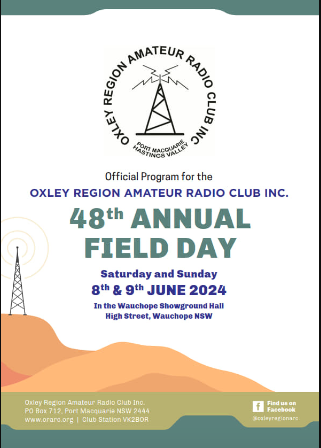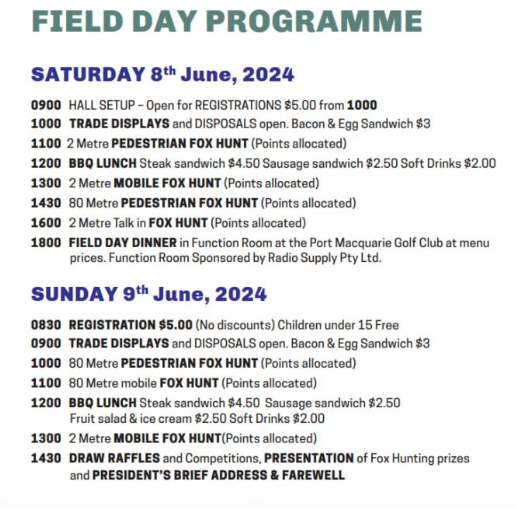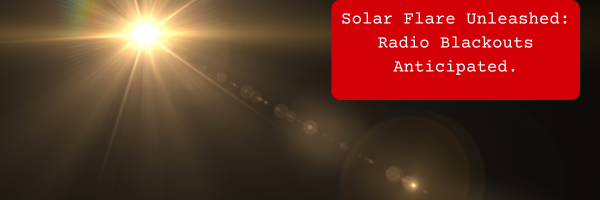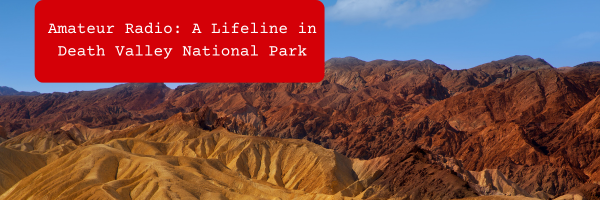The Oxley Region Amateur Radio Club Annual Field Day is back! Join in at the Wauchope Showground Hall on June 8-9, 2024, during the King’s Birthday Long Weekend for all the usual field day activities.

Enjoy a weekend packed with fun activities:
- Pedestrian Fox Hunt: A thrilling shortwave radio treasure hunt on foot.
- Mobile Fox Hunt: Hunt down hidden transmitters while on the move.
- Regular Fox Hunt: Test your skills in locating hidden shortwave radio transmitters.
- Sausage Sizzle & BBQ Lunch: Delicious food to keep you energized.
- Trade Displays & Disposals: Check out and buy the latest radio gear.
- Raffles, Presentation & President’s Address: Exciting prizes and insights from our club president.
- Prizes awarded for fox hunts!!!
Don’t miss the Field Day Dinner at the Port Macquarie Golf Club on Saturday night.
Camping is available at the Wauchope Showground with power and amenities for motorhomes, caravans, and tents.
Mark your calendar for a weekend of radio fun and camaraderie!

Check the clubs official field day page here https://www.orarc.org/?p=70508

The Sun has once again demonstrated its immense power by unleashing a significant solar flare, causing radio blackouts here on Earth. This latest event highlights the increasing activity as we approach the solar maximum of Solar Cycle 25, a period marked by frequent solar eruptions.
A Record-Breaking Flare
On Tuesday, the Sun emitted a massive storm of energized particles, recorded as the most powerful flare in the current solar cycle. Designated as an X8.7 category flare, it surpasses the strength of recent solar activities. According to data from the National Oceanic and Atmospheric Administration (NOAA), this flare originated from an active sunspot labelled AR3664, situated at the very edge of the Sun’s visible hemisphere.
Impacts on Earth
The implications of this solar event were significant. Parts of Earth, particularly the United States, experienced radio blackouts due to the intense electromagnetic radiation from the flare. In Australia amateurs reported very poor HF propagation. The Tecsun SDR showed almost no noise (or signals) across the HF spectrum for several days. These blackouts disrupted communication systems, navigation, and other technologies reliant on radio waves.
Understanding Solar Cycle 25
Solar Cycle 25, which began in December 2019, is now approaching its solar maximum—a phase where solar activity peaks, leading to more frequent and intense solar flares and coronal mass ejections (CMEs). These solar phenomena are a natural part of the 11-year solar cycle, driven by the Sun’s magnetic field.
Preparing for Solar Events
As we continue through this period of heightened solar activity, scientists and agencies like NASA and NOAA closely monitor the Sun’s behaviour. This vigilance helps in forecasting space weather events and mitigating their impact on Earth’s technological infrastructure.
The recent X8.7 solar flare serves as a reminder of the dynamic and powerful nature of our star. While the immediate effects might be limited to radio blackouts, the broader implications of increased solar activity underscore the importance of ongoing observation and preparedness.
Stay tuned for further updates as Solar Cycle 25 continues to unfold, bringing with it both challenges and opportunities to deepen our understanding of the Sun-Earth connection.
 In the vast expanse of Death Valley National Park, a remote desert in southern California, modern connectivity often falls short. On a fateful Saturday, April 6, a family’s adventure took an unexpected turn when their vehicle became trapped in mud in a hazardous area, leaving them without cell service. In this critical moment, amateur radio proved to be their saving grace.
In the vast expanse of Death Valley National Park, a remote desert in southern California, modern connectivity often falls short. On a fateful Saturday, April 6, a family’s adventure took an unexpected turn when their vehicle became trapped in mud in a hazardous area, leaving them without cell service. In this critical moment, amateur radio proved to be their saving grace.
Caleb Gustwiller, KD8TGB, a dedicated radio amateur from Ohio, sprang into action upon receiving the distress call. Monitoring the 10-meter band, Gustwiller managed to pick up the call sign and approximate location of the ham in distress. Despite losing the signal amidst the noise, he swiftly turned to the Parks on the Air® Facebook group, rallying fellow hams to lend their ears and assistance.
Thanks to the collective efforts of the amateur radio community, several hams reached out to emergency officials in southern California. This timely intervention led to the rapid rescue of the stranded family by park rangers, averting what could have been a tragic outcome. The Black Swamp Amateur Radio Club emphasized the gravity of the situation, stating, “Without Caleb hearing this distress call, it could have quickly become a very deadly situation for the operator and his family.”
This remarkable incident underscores the invaluable role of amateur radio in providing communication lifelines, especially in remote and challenging environments. It serves as a powerful reminder of the importance of community, collaboration, and the enduring spirit of ham radio operators worldwide.
*Full credit to the source for this article ARRL Letter (http://arrl.org/arrlletter?issue=2024-04-11)*


